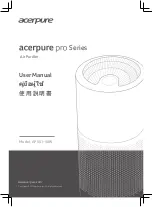
43
Installation Manual
Due to our policy of continuous product innovation, some specifications may change without notification.
©LG Electronics U.S.A., Inc., Englewood Cliffs, NJ. All rights reserved. “LG” is a registered trademark of LG Corp.
REFRIGERANT PIPING
A properly installed pipe system will have sufficient support so that pipes will not sag during the life of the system. As necessary, place supports
closer for segments where potential sagging could occur. Maximum spacing of pipe supports must meet local codes.
Refrigerant Pipe Connections
Indoor units come with flare type connections. It is the installer’s option to use the flare fittings provided or braze the indoor unit to the
refrigerant piping system.
Flare Fittings
•
All unit flare fittings are 45° and rate for high-pressure R410A refrigerant.
•
Properly form all flare fittings using best practices.
•
Place a drop of PVE oil on the outside of the flare fitting before
tightening.
Note:
Multi V refrigeration system components contain very small capillary
tubes, small orifices, electronic expansion valves, oil separators, and
heat exchangers that can easily become blocked.
Max. 12"
~ 12" – 19"
A
B
A + B ~ 12" – 19"
Figure 22: Pipe Support at Indoor Unit.
Figure 23: Typical Pipe Support Location—Change in Pipe Direction.
Note:
•
Do not use any other type of oil (including traditional POE refrig-
eration oil) as a lubricant. Failure to follow this procedure may lead to
restrictions in the refrigeration components.
•
Do not over-tighten flare nuts. Excessive tightening will cause
fittings to crack.
Insulate Refrigerant Pipes
Sufficiently insulate all cold surfaces to prevent moisture forming. All
pipes must be insulated and each pipe must be separately wrapped.
Refer to Figure 24 and Figure 25. Use field-provided one-half (1/2)
inch thick (or thicker) closed-cell insulation. The thickness may need
to be increased based on ambient conditions and local codes.
Wrap all refrigerant and condensate piping including field-provided
isolation ball valves and flexible pipe connection kits provided by LG.
Glue all insulation joints with no air gaps between insulation seg-
ments, and between insulation segments and the unit case. Ensure
insulation material fits snugly against the refrigeration pipe with no air
space between the pipe surface and the surrounding insulation.
Protect insulation inside hangers and supports with a second insula-
tion layer. Ensure insulation on all pipe passing through pipe hangers,
inside conduit, and/or sleeves is not compressed.
Figure 24: Typical Refrigerant Line Flare Fitting Insulation Detail
No Clearance
Overlap Insulation Where the
Port and the Piping Meet
Insulation for Indoor Unit Port
(Field Supplied) Insulation for Refrigerant
Piping (Field Supplied)
Insulation Clip (Field Supplied)
Figure 25: No Air Gap in Pipe Insulation to Indoor Unit Frame.
















































